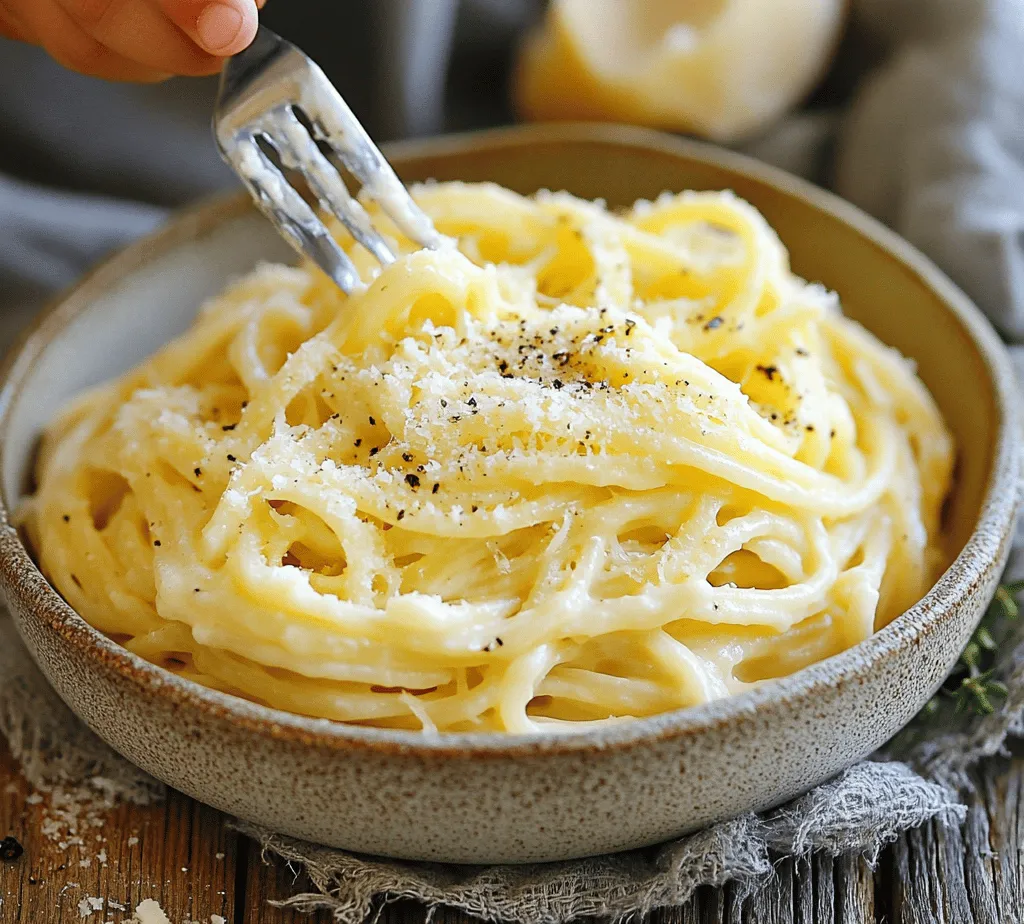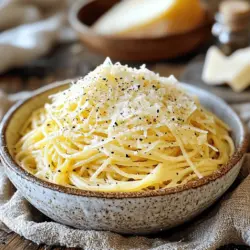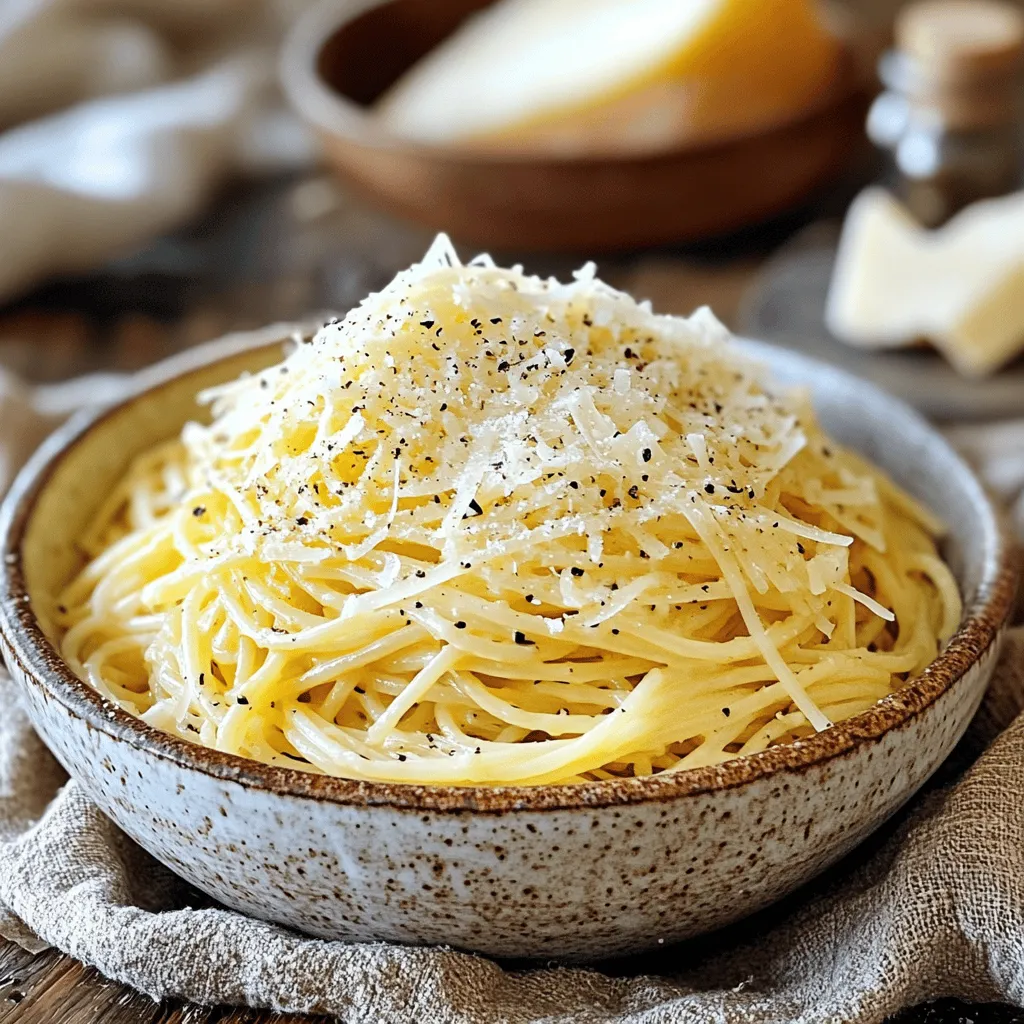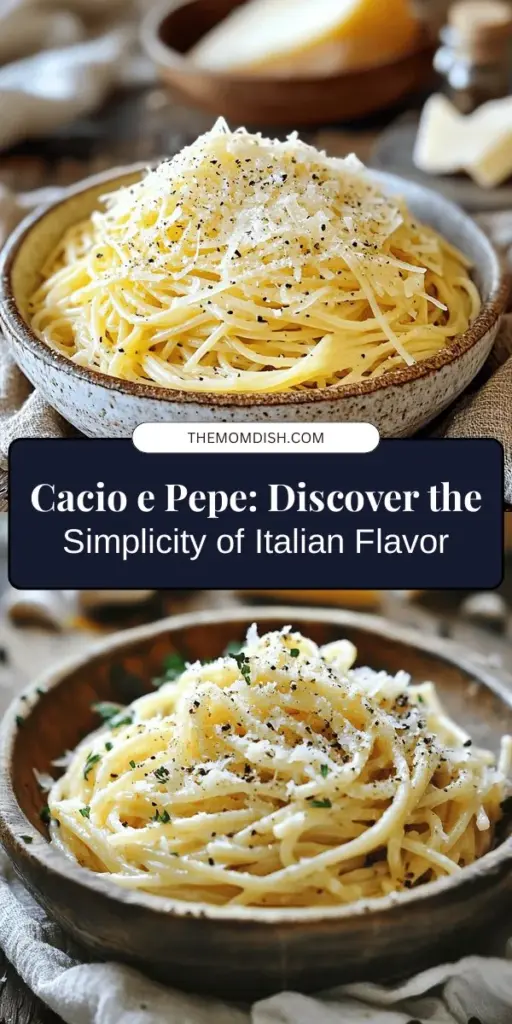Cacio e Pepe, a timeless Italian classic, captivates food lovers with its simplicity and flavor. The very name translates to “cheese and pepper,” which perfectly encapsulates the essence of this dish. It is an exquisite representation of how a few quality ingredients can come together to create something utterly delicious. Cacio e Pepe is not just a meal; it’s a celebration of Italian culinary tradition, where the focus is on technique and the quality of the ingredients rather than complex preparations. Whether you’re a novice in the kitchen or a seasoned chef looking for a dish that showcases your skills, this recipe for Cacio e Pepe Bliss is essential.
As we delve into this article, we will uncover the rich history that surrounds Cacio e Pepe, the importance of using high-quality ingredients, and provide a step-by-step guide to crafting your very own Cacio e Pepe Bliss.
The Rich History of Cacio e Pepe
Understanding the origins of Cacio e Pepe enhances our appreciation for this dish and its enduring presence in Italian cuisine.
The Roots of Cacio e Pepe in Roman Cuisine
Cacio e Pepe hails from Rome, where it was traditionally consumed by shepherds who needed a simple, hearty meal that could be prepared quickly with minimal ingredients. The dish’s origins trace back to the Roman countryside, where the shepherds would carry with them small amounts of pasta, cheese (specifically Pecorino Romano), and black peppercorns. These ingredients were easily transportable and could be cooked over an open fire, making it an ideal meal for those on the go.
Historical Significance in Italian Culture
As time went on, Cacio e Pepe transcended its humble beginnings, becoming a beloved dish not only in Roman kitchens but also in restaurants across Italy and beyond. The dish reflects the Italian philosophy of “cucina povera,” or “poor kitchen,” which emphasizes the use of simple, inexpensive ingredients to create nourishing meals. It showcases the Italian culinary tradition that values quality over quantity, and its straightforward preparation has inspired countless chefs and home cooks alike.
How It Became a Staple in Households and Restaurants
Today, Cacio e Pepe is revered as a staple in both homes and restaurants. Its popularity has soared in recent years, particularly with the rise of minimalist cooking trends. Chefs appreciate the challenge of perfecting this dish, as it requires a delicate balance of flavors and the right technique to achieve a creamy, velvety sauce without the use of cream.
Cacio e Pepe has also made its mark on social media, with countless food enthusiasts sharing their own takes on the classic recipe, further cementing its status as a beloved dish around the globe.
Key Ingredients and Their Importance
A closer look at the key ingredients reveals why Cacio e Pepe holds a special place in the hearts of many food lovers.
The Role of Spaghetti or Tonnarelli
The choice of pasta is crucial in Cacio e Pepe. Traditionally, spaghetti is used; however, tonnarelli, a thicker, square-cut pasta, is also favored for its ability to hold onto the sauce. When selecting pasta, opt for high-quality dried pasta made from durum wheat semolina. This type of pasta not only offers a pleasing texture but also holds up well during cooking, contributing to the overall success of the dish.
Pecorino Romano Cheese: Characteristics and Flavor Profile
Pecorino Romano cheese is the star of the show in Cacio e Pepe. This hard, salty cheese made from sheep’s milk boasts a robust flavor profile that is both tangy and nutty. Its saltiness enhances the dish and creates a rich, creamy texture when mixed with the pasta. When buying Pecorino Romano, look for a block of cheese that you can grate fresh. Pre-grated cheese often lacks the depth of flavor and creaminess needed for this recipe.
The Significance of Freshly Cracked Black Pepper
Freshly cracked black pepper is another essential ingredient that brings warmth and depth to Cacio e Pepe. The aromatic quality of freshly ground pepper elevates the dish, creating a balance with the richness of the cheese. Avoid pre-ground pepper, as it loses its potency and flavor over time. Invest in a good pepper grinder to ensure you achieve the perfect consistency for your dish.
The Importance of Salt in Pasta Cooking Water
Salt is integral to the cooking process, particularly in the pasta water. It is essential to season the water generously, as this is the primary opportunity to infuse flavor into the pasta itself. The pasta will absorb some of the salt as it cooks, creating a more flavorful foundation for the Cacio e Pepe.
The Role of Reserved Pasta Cooking Water in Achieving Creaminess
One of the secrets to achieving that signature creamy consistency in Cacio e Pepe lies in the reserved pasta cooking water. As the pasta cooks, it releases starch, which, when combined with the cheese and pepper, creates an emulsion that binds the ingredients together. Be sure to reserve some of the cooking water before draining the pasta, as it will be crucial in achieving the perfect sauce.
Step-by-Step Guide to Making Cacio e Pepe Bliss
Now that we understand the history and significance of the key ingredients, let’s dive into the step-by-step process of making Cacio e Pepe Bliss. Follow these detailed instructions to master this classic dish.
Cooking the Pasta: Techniques for Perfect Al Dente
1. Bring a Large Pot of Water to a Boil: Start by filling a large pot with water and adding a generous amount of salt—about 1-2 tablespoons per liter of water. Bring the water to a rolling boil over high heat.
2. Add the Pasta: Once the water is boiling, add your spaghetti or tonnarelli to the pot. Stir immediately to prevent the pasta from sticking together.
3. Cook to Al Dente: Follow the package instructions for cooking time, but begin checking for doneness a minute or two before the suggested time. The pasta should be cooked al dente, meaning it should be firm to the bite while still retaining some texture.
4. Reserve the Pasta Water: Before draining the pasta, make sure to reserve about 1-2 cups of the cooking water. Set it aside in a bowl to use later in the recipe.
Preparing the Cheese and Pepper Mix: Tips for the Best Blend
1. Grate the Pecorino Romano: While the pasta cooks, grate the Pecorino Romano cheese using a fine grater. Aim for a light, fluffy texture to ensure it melts smoothly into the pasta.
2. Prepare the Pepper: In a dry skillet over medium heat, add freshly cracked black pepper. Toast the peppercorns for about 30 seconds, just until fragrant. This step enhances the pepper’s flavor, making it a prominent element in the dish.
3. Combine Cheese and Pepper: In a mixing bowl, combine the grated Pecorino Romano and the toasted black pepper. Mix them well to create a uniform blend.
Combining Pasta and Cheese: Achieving the Perfect Consistency
1. Toss the Pasta: Once the pasta is cooked to al dente, drain it using a colander. Do not rinse the pasta, as you want to retain the starch that will help create the sauce. Immediately transfer the hot pasta to a large mixing bowl.
2. Add the Cheese and Pepper Mixture: While the pasta is still hot, sprinkle the cheese and pepper mixture over it.
3. Incorporate Reserved Pasta Water: Now, slowly add reserved pasta water, a few tablespoons at a time, while tossing the pasta vigorously. This process helps the cheese melt and form a creamy sauce that clings to the pasta. Continue adding water and tossing until you reach the desired consistency.
4. Serve Immediately: Cacio e Pepe is best served fresh and hot. Plate it up and finish with an extra sprinkle of Pecorino Romano and a few cracks of black pepper on top for garnish.
By following these steps, you will create a dish that embodies the heart of Italian cuisine. Cacio e Pepe Bliss is a testament to the power of simplicity in cooking, and it’s a recipe that you will cherish for years to come.

Adjusting the Sauce: Finding the Right Balance with Pasta Water
One of the key elements of achieving the perfect Cacio e Pepe is mastering the art of adjusting the sauce. The secret lies in the use of pasta water, which is rich in starch and helps create a luscious, creamy texture that adheres to the pasta beautifully. As you cook the spaghetti, be sure to reserve about a cup of pasta water before draining.
Once you combine the cheese and pepper with the pasta, gradually add small amounts of the reserved pasta water. Start with a few tablespoons at a time, tossing the pasta vigorously to emulsify the cheese and water into a smooth sauce. The goal is to create a silky consistency that coats each strand of spaghetti without being overly watery. If the sauce seems too thick, add a little more pasta water until you reach the desired creaminess. Keep in mind that the heat from the pasta will continue to melt the cheese, so adjust accordingly as you mix.
Serving Suggestions: Presentation Tips for a Restaurant-Quality Dish
Presentation can elevate your Cacio e Pepe from a simple meal to a restaurant-quality experience. Here are some tips to make your dish not only delicious but visually appealing:
1. Plate with Care: Use a large, shallow bowl or a wide plate to serve your pasta. Twirl the spaghetti into a nest shape using a fork or tongs, which adds height and elegance.
2. Garnish Thoughtfully: A sprinkle of freshly cracked black pepper and a light dusting of extra grated Pecorino Romano can enhance both flavor and aesthetics. Consider adding a few fresh basil leaves or a sprig of parsley for a pop of color.
3. Temperature Matters: Serve the pasta immediately after tossing with the sauce to ensure it retains its warmth and the sauce remains creamy. If the pasta sits too long, it may clump together.
4. Accompaniments: Consider serving with a slice of crusty Italian bread or a side of olive oil for dipping. This not only complements the dish but also adds an extra layer of indulgence.
Flavor Variations and Customizations
While the traditional Cacio e Pepe is a delight on its own, you can explore various flavor enhancements to personalize your experience:
– Adding Garlic for Depth of Flavor: For those who enjoy a hint of garlic, consider adding minced garlic to the pan while toasting the pepper. This will infuse the oil with a subtle yet fragrant flavor that beautifully complements the cheese.
– Incorporating Herbs: Fresh herbs can uplift the dish with vibrant flavors. Chopped parsley or basil can be sprinkled on top just before serving, adding freshness and a touch of color.
– Alternative Cheeses: While Pecorino Romano is traditional, you can experiment with other cheeses like Parmigiano-Reggiano or a blend of both for a different taste profile. Each cheese brings its unique characteristics, enhancing the overall flavor of the dish.
– Vegetable Additions: For a nutritional boost, consider adding vegetables such as sautéed spinach, roasted cherry tomatoes, or steamed broccoli. These additions work well in balancing the richness of the cheese while introducing fresh flavors.
Pairing Suggestions with Cacio e Pepe
To create a well-rounded meal, consider pairing your Cacio e Pepe with complementary dishes and beverages:
– Recommended Salads: A simple arugula salad with lemon vinaigrette or a classic Caesar salad can provide a refreshing contrast to the richness of the pasta. The crisp greens and zesty dressing will cleanse the palate between bites.
– Ideal Wines: Pairing wine with Cacio e Pepe can enhance the dining experience. A crisp white wine like Pinot Grigio or a light-bodied red such as Chianti will complement the dish without overpowering it. The acidity in these wines helps balance the creaminess of the cheese.
– Side Dishes: To round out your meal, consider serving a side of sautéed vegetables or a light risotto. These dishes can add texture and flavor variety while maintaining a harmonious dinner experience.
Nutritional Information of Cacio e Pepe
Understanding the nutritional aspects of Cacio e Pepe can help you appreciate the dish even more. Here’s a breakdown of the dish’s caloric content and its benefits:
– Caloric Breakdown of the Ingredients: A typical serving of Cacio e Pepe (about 1 cup) can range from 400 to 600 calories, depending on the amount of cheese and pasta used. The primary contributors to the calorie count are the spaghetti and the Pecorino Romano cheese.
– Macronutrient Profile per Serving: On average, a serving may contain:
– Carbohydrates: 60-70g
– Protein: 15-20g
– Fat: 15-25g
This macronutrient balance provides a satisfying meal, with carbohydrates for energy and protein from the cheese.
– Potential Health Benefits: The ingredients in Cacio e Pepe have their own health benefits. For instance, Pecorino Romano is a good source of calcium, which is essential for bone health. The black pepper used in the recipe has anti-inflammatory properties and can aid digestion when consumed in moderation.
Conclusion
Cacio e Pepe is more than just a dish; it’s a celebration of Italian culinary tradition that brings comfort and joy to the table. With its straightforward preparation and rich flavors, this recipe is perfect for any occasion, whether a family dinner or a special gathering. By mastering Cacio e Pepe, you not only enrich your cooking repertoire but also connect with the heart of Italian cuisine. Enjoy each bite, knowing you are partaking in a dish that has delighted palates for generations.
As you experiment with variations, pairings, and presentation tips, you’ll discover that Cacio e Pepe can be as versatile as it is comforting. Each plate can tell a different story, inviting you and your loved ones to savor the simple yet profound flavors of Italy. So gather your ingredients, embrace the cooking process, and relish the delightful experience of creating your own Cacio e Pepe bliss.



